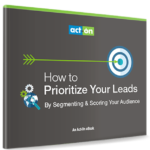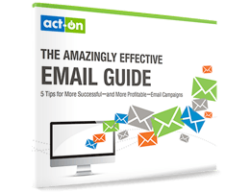Email marketers know that even small incremental increases in response rates can provide exponentially better results. However, in a recent survey that Ascend2 and Act-On did (full report coming soon), 64% of marketers say click-through rates are increasing only modestly, or not changing at all:
But you don’t have to be average. Let’s take a closer look at three ways to buck the flat-rate trend, and get better email response rates for your campaigns.
1. Mobile moves the needle
In January of 2015, Litmus reported that 53 percent of emails are opened on mobile. As a stark contrast, just 8 percent of emails were opened on a mobile device in 2011. Our email reading habits are changing, and our email sending habits must follow the curve, or (even better) get ahead of it. One thing we know for sure: if your emails aren’t working well on mobile devices, you’re going to lose traction with your subscribers. Especially if you’re a tech company, or anyone else who positions themselves or their companies as trend-forward.
You want messages that are easy to read and easy to access, with bullet-proof, easy-to-tap calls to action. If an email requires too much scrolling or the link is too small, too difficult to access, or too hard to see, you’re courting your recipient’s frustration and inadvertently asking to be deleted.
If you aren’t testing your email messages on mobile, start today. At the very least, send yourself a test message, access it on your mobile device, click on a call to action, go all the way through the process and ask yourself, “Is this email easy to read and interact with?”
Your best bet is to design an email that is based on responsive design from the get-go. That way, your recipient could be in the office, at the airport, in a cab, in a waiting room – anyplace at all, on any device at all, and your message will come through loud and clear, exactly as you intended it.
Read Tim Asimos’ thorough blog post on responsive design for more information.
2. Know thy customer
Lyris found that 39 percent of marketers who segmented their email lists experienced higher open rates, 28% experienced lower unsubscribe rates, and 24 percent experienced better deliverability and greater revenue.
So, what is segmentation and how do you do it?
Segmentation has been around a long time. Decades ago, an advertiser selling face powder might buy television ads by segments: Which shows pull women 18–34?
Today we do the same thing, only most companies don’t center it on the product; they center it on the customer. From the time a prospect begins interacting with you until they buy, and then until they re-buy, they are giving you information:
- How did they find you?
- What web page link did they click on?
- Did they fill out that form?
- What did they download?
- Which emails do they open and click on?
- What did they buy?
- What did they (metaphorically) send back?
- Did they get through training on time?
- What kind of customer feedback do you get from them?
- What are they saying about you on review sites and in social forums?
- How many stars did they give you?
Depending on what you sell, you should be able to segment your subscribers and prospects in multiple ways: criteria such as size of company and ability to buy. Products they are interested in. Problems they want to solve. Geographic location. Other technologies they use. Competitors they work with. Whether they’ve attended your webinars. Where they are in your sales funnel (early, middle, bottom). Whether they’ve joined your customer community. And so on.
You don’t need to know everything, but you need to know enough so that when you make an offer, you’re pretty sure it’s the right offer … and you’re pretty sure they have good reason to say yes.
Want to learn more? Check out our ebook, How to Prioritize Your Leads by Segmenting & Scoring Your Audience.
3. You talkin’ to me?
You really should be able to answer yes to that question; your recipient should open your email and feel like it’s meant for their specific eyes.
What we call personalization is the fine art (with a little science thrown in) of putting segmentation to work – knowing who your subscribers are and what they care about. Nordstrom, usually a diligent practitioner of mind-reading, consistently tries to sell a male colleague of mine little black dresses. Call it anti-personalization; Nordstrom is earning his amusement, and a bit of ill-will, rather than his trust.
Figure out two or three ways you could personalize emails, such as “Dear Jack…I couldn’t help but notice your interest in our Jumbo Widgets...” (that one could even be a trigger email from a web page that looks like a personal email from a sales rep). Then test, and test, and test again, until you’ve got something you can reasonably expect to work to raise your response rate.
Another consideration: you may not want (or have the staff) to do as many different emails as you have segments. Dynamic content could be your savior here. Build one email with dynamic components, and you can address different types of buyers with content that feels personal to them.
A recent story on CMO.com, 15 Mind-Blowing Stats About Personalization, reviewed what it takes to make personalization work. Among the stats:
In order to be able to personalize experiences for potential and existing customers, companies must first have a single customer view. The top three challenges in achieving this view are inability to link different technologies (40%), poor data quality (34%), and lack of relevant technology (32%). (Bold text ours.)
 Ahem: Marketing automation can solve that single-customer-view problem. Just sayin’.
Ahem: Marketing automation can solve that single-customer-view problem. Just sayin’.
Would you like to see how marketing automation can spur your response rates? Check out our ebook, The Amazingly Effective Email Guide and learn five tips for creating more successful – and profitable – email campaigns.
